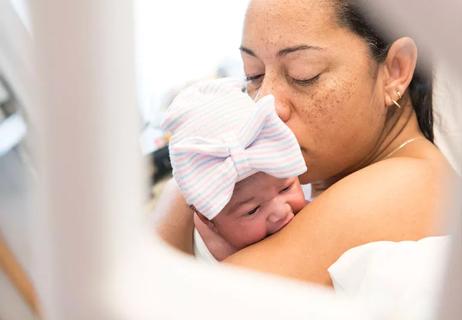Advice from a certified nurse midwife

Do you long to have your baby without medication and an array of beeping medical equipment in the room? If so, water labor may seem like an appealing option.
Advertisement
Cleveland Clinic is a non-profit academic medical center. Advertising on our site helps support our mission. We do not endorse non-Cleveland Clinic products or services. Policy
Some women find it to be more comfortable, while helping labor progress naturally — especially if they’re planning for a drug-free birth.
Water labor is exactly what it sounds like: You’ll go through some or all of your active labor in a clean, warm tub.
This option is typically best for healthy women with uncomplicated pregnancies who don’t want medication during labor. Some hospitals have rooms designed for this.
One of Cleveland Clinic’s birthing sites offers rooms with large tubs that are drained and refilled to maintain a constant, comfortable water temperature. A handheld shower head can help ease sore stomach and back muscles and promote relaxation.
Advertisement
If you want to deliver your baby without medication and you’re expecting a traditional (low-intervention) birth, you could consider water labor. Hudson says it’s typically an option for women who:
It’s even an option for women who have had a C-section, have (well-controlled) diabetes or may need regular monitoring during labor, Hudson says. Newer technology such as wireless monitoring systems or telemetry is available in some locations, she notes.
Water labor is likely not a good option for those who have:
While many hospitals around the country offer women the opportunity to labor in water, actually delivering in water is a slightly more controversial topic.
Many hospitals no longer offer water delivery. In 2016, the American Academy of Pediatrics and American College of Obstetrics and Gynecology issued a joint statement saying that water birth is an experimental procedure and that they felt there was little evidence that it improves delivery. In fact, they stated, it may increase the risk of infection.
The organizations say water delivery can increase the risk of umbilical cord damage and make it difficult to regulate a newborn’s temperature. They also suggest that there is a risk of respiratory distress or asphyxia if a baby inhales tub water during delivery.
Hudson says water delivery can be safe and effective for many mothers. Cleveland Clinic, she says, is working on protocols to re-initiate the practice in its birthing center. If you are considering a water labor or delivery, consult with your midwife or physician about your options, she advises.
Advertisement
Learn more about our editorial process.
Advertisement

Placenta consumption hasn’t been shown to have any health benefits, but it can cause infections

Sitting, squatting and side-lying may provide a more comfortable labor and delivery

Use relaxation techniques and breathwork to help manage the discomforts of a medication-free birth

Rinses, sitz baths, ice and medication can help the healing

Babies aren’t great about scheduling, so be sure to pack a month or two before your due date

You can plan for almost anything, but be flexible about the outcome

There are risks to having a C-section and benefits to vaginal birth

What to expect after having surgery

If you’re feeling short of breath, sleep can be tough — propping yourself up or sleeping on your side may help

If you fear the unknown or find yourself needing reassurance often, you may identify with this attachment style

If you’re looking to boost your gut health, it’s better to get fiber from whole foods